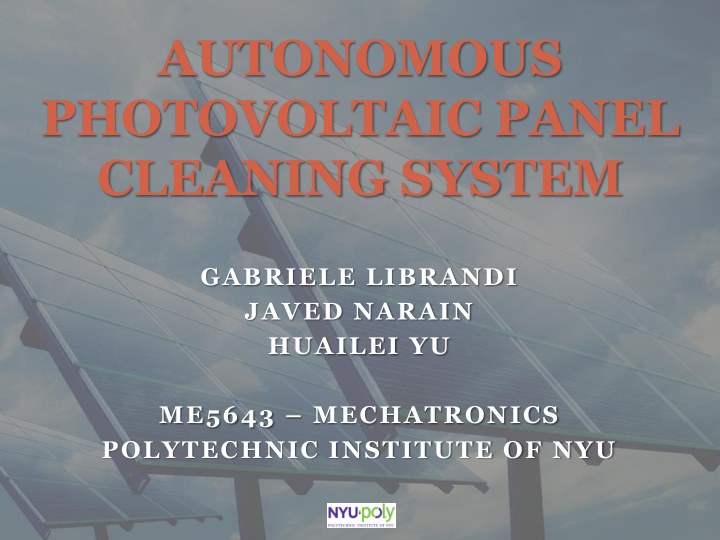



AUTONOMOUS PHOTOVOLTAIC PANEL CLEANING SYSTEM GABRIELE LIBRANDI JAVED NARAIN HUAILEI YU ME5643 – MECHATRONICS POLYTECHNIC INSTITUTE OF NYU
Overview Project Outline Project Need Project Motivation Background Solar Panel Project Description Hardware Circuit Operational Flow Chart Prototype Cost Discussion Advantages/Disadvantages Future Work References 12/17/2012 Autonomous Photovoltaic Panel Cleaning System
Project Outline Autonomously clean photovoltaic (PV) panels 1. Climbing up on the roof may be dangerous Hiring a company could cost up to $1600 annually Solution would not include the use of water 2. Ideal locations for PV panels are in areas with high sunshine & as a result, less water System would have to determine when there is the need 3. for self cleaning Cannot rely simply on a reduction in voltage as this would be the case in the night and on a cloudy day In the event of a malfunction, there should be a way of 4. automatically shutting off the system 12/17/2012 Autonomous Photovoltaic Panel Cleaning System
Project Need Airborne dust particles can reduce efficiency by up to 7% (U.S. Dept of Energy) Efficiency reduced by up to 30% when adding in falling leaves & water streaking $10,000 of lost value in its lifetime for residential Significantly higher for a large scale Solar farm. Autonomous Photovoltaic Panel Cleaning System 12/17/2012
Project Motivation All members were interested in “green” technology Hurricane Sandy left us all without power & revealed, even more, the significance of global warming Solar Decathlon 2013 Competition Build a zero-energy emission home Uses solar panels This is a real problem Mars rover Curiosity was switched from Solar power to Nuclear power because of the dust storms on Mars 12/17/2012 Autonomous Photovoltaic Panel Cleaning System
Solar Panels Photovoltaic comes from photo for light and voltaic for electricity PV cells are made of semiconductor material, most commonly silicon Silicon is coated with an antireflective coating to reduce losses from photons bouncing away Finally, it is covered with a glass plate to protect it from the elements. 12/17/2012 Autonomous Photovoltaic Panel Cleaning System
Solar Panel Specifications of interest: • 9 VDC Max Output • Dimensions: 5.3 x 5.3 x 0.1 ‘’ (135 x 135 x 2.8 mm) • Operating temperature range: +32 to +158 °F (0 to + 70 °C) • Already mounted positive and negative wires Autonomous Photovoltaic Panel Cleaning System 12/17/2012
Microcontroller: BASIC Stamp 2 (BS2) Specifications of interest: • Good know-how by the team’s members • Good processor speed: 20 MHz • Operating temperature range: -40 to +185 °F (- 40 to + 85 °C) Autonomous Photovoltaic Panel Cleaning System 12/17/2012
Actuator: Parallax Standard Servo Specifications of interest: • Holds any position between 0 and 180 degrees • 38 oz-in torque at 6 VDC (0.268 N-m) • Perfectly interfaced with PBASIC STAMP 2 • Simple to control with the PULSOUT command PBASIC • Operating temperature range: +14 to 144 °F (-10 to 62 °C) Autonomous Photovoltaic Panel Cleaning System 12/17/2012
Actuator: Parallax Continuous Servo Specifications of interest: Bidirectional rotation • 38 oz-in torque at 6 VDC (0.268 • N-m) Perfectly interfaced with PBASIC • STAMP 2 Simple to control with the • PULSOUT command PBASIC Low weight, 1.50 oz (42.5 g) • Operating temperature range: +14 • to 122 °F (-10 to 50 °C) Autonomous Photovoltaic Panel Cleaning System 12/17/2012
Sensor: Parallax Photoresistor, VT935G-B Specifications of interest: • Resistance in light condition ~ 20 kΩ • Resistance in dark condition ~ 1 MΩ • Rise time 35 ms • Fall time 5 s Autonomous Photovoltaic Panel Cleaning System 12/17/2012
Sensor: Digital Thermometer, DS1620 Specifications of interest: • Measures temperature within +/- 0.5°C error • Perfectly interfaced with PBASIC STAMP 2 • Power requirements: 2.7 to 5.5 VDC • Operating temperature range: -67 to +257 °F (-55 to +125 °C) Autonomous Photovoltaic Panel Cleaning System 12/17/2012
Circuit
Operational Flow Chart 12/17/2012 Autonomous Photovoltaic Panel Cleaning System
Prototype Cost
Demonstration We will now demonstrate our prototype!
Cleaning 1 st Glass
Operating Temperature
Cleaning Solar Panel
Advantages/Disadvantages ADVANTAGES: DISADVANTAGES: Autonomous self-cleaning “Wiper Blade” which consists of mechanism that can be an electrostatic cloth would attached to solar panels and need to be changed operated without human Needs to be scaled for larger operation projects (ex: increasing the Maximize the efficiency of the torque of the motors) solar panels, resulting in these System is not powered by the panels to pay-off earlier photovoltaic cells; instead it is Easy to construct, low cost and battery powered low maintenance System used 2 continuous servo Allow for the system to be motors; standard servo motors cleaned only when necessary are better.
Future Changes Design a better “wiper blade” so that changing it is required much less often and much easier. Also, increasing the contact force Interface the 9V solar panel with the BS2 to power the system using a regulator such as the LM7805 Use 3 standard servo motors instead of continuous servos since we noticed that the continuous servos sometimes are a bit off, not always going back to the initial position
References Kapila, V. Class Lecture. Polytechnic Institute of NYU, Brooklyn, NY. 2012. Toothman, Jessika, and Scott Aldous. "How Solar Cells Work" 01 April 2000. HowStuffWorks.com. <http://science.howstuffworks.com/environmental/energy/solar- cell.htm> December 2012. "The Hidden Dirt On Solar Panels." The Hidden Dirt On Solar Panels. HELIOTEX, n.d. Web. Dec. 2012. <http://www.solarpanelcleaningsystems.com/solar-panel-hidden-dirt.php>. "How to Clean Solar Panels." WINSOL Laboratories. N.p., n.d. Web. Dec. 2012. Liggett, Brit. "New Mars Curiosity Science Laboratory Will Be Nuclear Powered Instead of Solar." Inhabitat Sustainable Design Innovation Eco Architecture Green Building New Mars Curiosity Science Laboratory Will Be Nuclear Powered Instead of Solar Comments . N.p., n.d. Web. Dec. 2012.
Thank You! QUESTIONS?
Recommend
More recommend